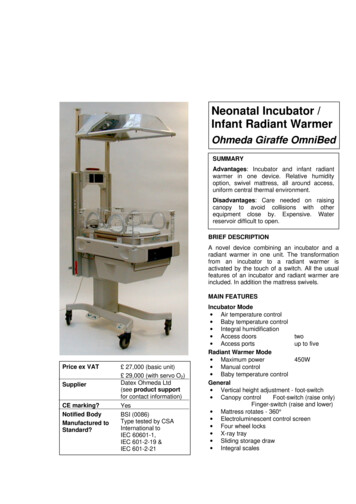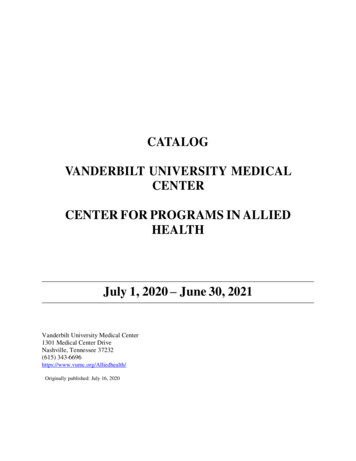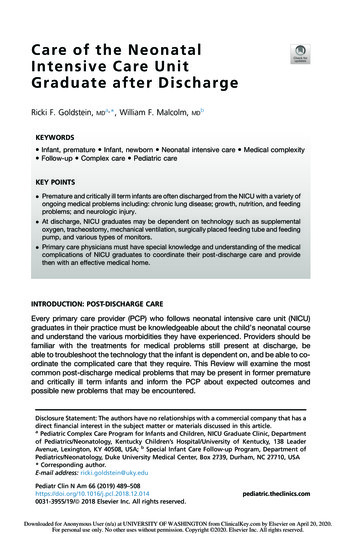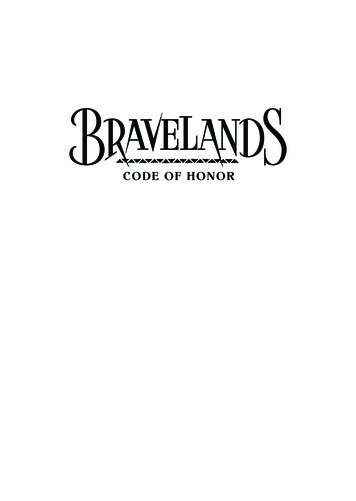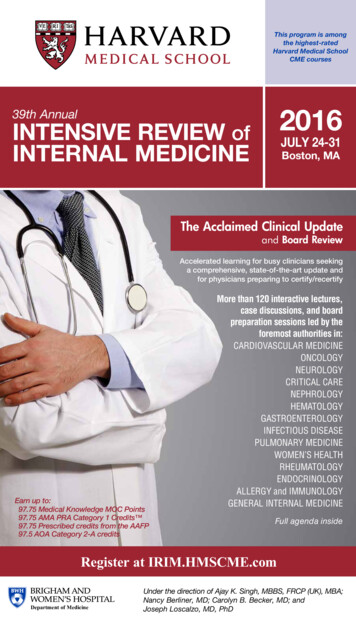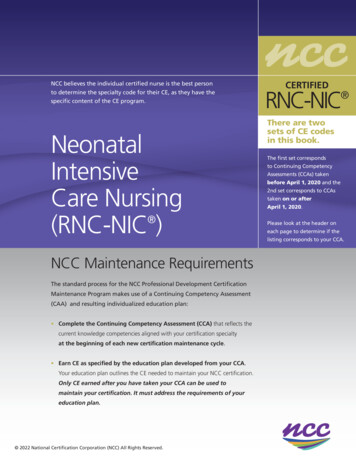
Transcription
NCC believes the individual certified nurse is the best personto determine the specialty code for their CE, as they have thespecific content of the CE program.NeonatalIntensiveCare Nursing (RNC-NIC )NCC Maintenance RequirementsThe standard process for the NCC Professional Development CertificationMaintenance Program makes use of a Continuing Competency Assessment(CAA) and resulting individualized education plan: Complete the Continuing Competency Assessment (CCA) that reflects thecurrent knowledge competencies aligned with your certification specialtyat the beginning of each new certification maintenance cycle. Earn CE as specified by the education plan developed from your CCA.Your education plan outlines the CE needed to maintain your NCC certification.Only CE earned after you have taken your CCA can be used tomaintain your certification. It must address the requirements of youreducation plan. 2022 National Certification Corporation (NCC) All Rights Reserved.CERTIFIEDRNC-NIC There are twosets of CE codesin this book.The first set correspondsto Continuing CompetencyAssessments (CCAs) takenbefore April 1, 2020 and the2nd set corresponds to CCAstaken on or afterApril 1, 2020.Please look at the header oneach page to determine if thelisting corresponds to your CCA.
CERTIFIEDCONTINUING COMPETENCYASSESSMENT (CCA)RNC-NIC The CE requirements for your NCC maintenance will be outlined in your education plan!Your educational plan is derived from your Continuing Competency Assessment (CCA) and outlines for youthe CE needed in each of your core competency areas. Each core area has a code and that code is providedfor you as well. Take the CCA as soon as you can in the beginning of your maintenance cycle.The CCA may be taken early, up to 3 months prior to the start of your new maintenance cycle date.The start day for earning CE remains at the first day of the new maintenance cycle. YOU CAN ONLY USE CE EARNED AFTER YOU HAVE TAKEN YOUR CCA FOR MAINTENANCE.ANY CE EARNED BEFORE YOU TOOK THE CCA CANNOT BE USED (EVEN IF IT MEETS YOUR EDUCATION PLAN).YOUR CE AND NCC MAINTENANCE REQUIREMENTSAll CE must be earned during your current maintenance cycle and after you have taken the CCA.All CE used for NCC maintenance is defined by the individuals Education Plan.All CE must be submitted online at NCCwebsite.org.All CE must be coded to the applicable core content area. See listing in this brochure.CE can be entered into the maintenance application any time after the assessment has been taken and on anongoing basis. All activities will be saved until the application is submitted.All CE must be accredited by an agency recognized by NCC.ACCREDITING AGENCIESAcademic credit is accepted as is CME credit. For continuing education credit to be accepted for the purposeof maintenance, the continuing education activity must be accredited by one of the agencies below. NCC State boards of nursing andState nursing associations Nursing, medical or health care organizations(this would include, for example, suchorganizations as: ANCC, ANN, AWHONN,NPWH, NANN, NANNP, ACOG, AMA, AAP, etc.) Colleges or universities For-profit or not-for-profit continuing educationorganizations provided that programssponsored by such organizations have beenaccredited for continuing education.Most of the for-profit organizations have achieved accreditation for their offering through a state board ofnursing or health care organization. Review accreditation details in the registration brochure you receivedwhen registering for the particular continuing education activity.THE NATIONAL CERTIFICATION CORPORATION2
COMMON CODING QUESTIONSI went to aconference withtopics that reflectmany differentcodes, how do Icode them?CERTIFIEDRNC-NIC You have two options:You can code to the content area that represents the majority of the contentpresented.ORYou can breakout content per code (You may combine different sessions of thesame content code.) and record total hours for each code, listing the sameconference for every content code entry.I could not list allOnce you meet or the CE requirements designated by your education planmy CE. I have many the application will automatically take you to the payment page. There is nomore hours but the need to enter more CE than is required.maintenanceapplication wouldnot let me list them.I was a preceptorfor new students,can I use this formaintenance andhow do I list it onthe application.How do I code it?10 hours of CE can be used for precepting students, in your same certificationspecialty area and role. (e.g. In order for a WHNP to use the credit they cannotpreceptor nurse midwives or residents – only WHNP students.) Orienting newstaff is NOT considered as preceptor hours. On the application select themore information link for the preceptorship code 24 and it will give youinformation on how to list the information. This is also applicable to anyof the “other” codes. You can only use these hours for baseline hours and nothours designated in the education plan assigned to a specific competency area.Baseline hours are listed as hours that are assigned to any competency area andappear at the bottom of your plan.I have multiplecertifications.Can I use the sameCE for both. Howcan I code it fortwo differentcertifications.If the CE is applicable to both areas and was earned in the appropriatetime frame for each certification, yes. But you still need to file a separatemaintenance application and fee for each certification. Each CE activity willbe coded to each application.Do I have to submita “MaintenancePre-approval”?Maintenance Pre-Approval is optional and not required. If you are unsureyour continuing education activities will meet your NCC maintenancerequirements, you can ask NCC to pre-approve your CE activities. There is anonrefundable fee for this service. Complete details are in the maintenancesection of NCCwebsite.org.THE NATIONAL CERTIFICATION CORPORATION3
HOW TO READ THE EDUCATION PLANCERTIFIEDRNC-NIC Competency areas where 7.5 specialty index is achieved, no CE is needed. Competency areas where 7.5 specialty index is not achieved, the hours of CE needed will be listed. Every plan has a minimum of 15 CE hours - these are called baseline hours. Even if a specialtyindex above 7.5 is achieved in every competency, there is still a CE commitment of 15 hours.Education plans that need 45 hours, do not have any baseline hours because those hours areassigned to the specific core competencies. Every plan is composed of a maximum of 50 and a minimum of 15 CE hours. Missed keywords are intended to show what specific topics had knowledge gaps within thatcompetency area. They are broad in scope and you are not required to cover all keywords or topicsfor your NCC certification maintenance Links to NCC CE modules are offered as a convenience. Use of NCC CE modules is optional –not required. NCC CE is provided as a way to provide affordable, easily accessible CE for thosewho may have limited CE options in their area or practice. Also CE earned for successfulcompletion of any NCC CE modules will automatically be entered and coded into your onlinemaintenance application 5 hours of credit is given for taking the assessment and may be applied to any CE need. The total number of hours needed will be listed in each specific core competency.THE NATIONAL CERTIFICATION CORPORATION4
NIC Core Competency AreaGeneral Assessment (Code 1)*15 hoursGeneral Assessment Physical and gestational age assessment Maternal factors affectingneonatal outcomes Risk assessment Thermoregulation Fluids and electrolytes Nutrition and feeding Oxygenation and acid homeostasis Developmental carePhysiology and Pathophysiology(Code 2)*20 hoursPhysiology and Pathophysiology Cardiac Respiratory Gastrointestinal (GI) Genitourinary (GU) Hematopoietic Neurologic Infectious Diseases Metabolic Genetics Head, ears, eyes, nose and throat Discharge planning and follow up Grieving process and family integrationPharmacology (Code 3*10 hoursPharmacology Drug therapies Pharmacokinetic principlesProfessional Practice (Code 4)*5 hoursPatient Safety Interprofessional communication Medication error prevention System error preventionFOR CCATESTSTAKENBEFOREAPRIL1,CERTIFIED2020.EDUCATION PLANRNC-NIC Your Education PlanCORE COMPETENCY AREAGeneral Assessment (Code 1)Physiology andPathophysiology (Code 2)Pharmacology (Code 3)Professional Practice (Code 4)Baseline HoursTotal 0.00 20.000.000.000.00 0.000.00 15.000.0035.00 hours 0.00 hoursAssessment Summary & ResourcesCORE COMPETENCY AREASPECIALTYINDEXMISSED KEYWORDSCEMODULESGeneral Assessment (Code 1)7.63view availablemodulesPhysiology andPathophysiology (Code 2)Developmental Care, OxygenationDisturbance, Fluid andElectrolyte Management6.45Hematopoietic, Cardiac, EENT,Genitourinary, GI, Infectious Diseases,Metabolic, Genetics, DischargePlanning and Follow Upview availablemodulesNeonatal Complications (Code 3)8.33Pharmacologic Principlesview availablemodulesPharmacology (Code 4)8.33Legal Issuesview availablemodules*Number of CE hours required if you do not achieve a specialty indexof 7.5 or more in the content area.Ethical Principles and TheoriesLegal Issues AffectingNeonatal Care Nursing Scope of practice Impaired nurse Legal terms Informed consentProfessional Practice Standards Evidence based practiceResearch Terminology Incorporation into practiceTHE NATIONAL CERTIFICATION CORPORATION5
CODING OUTLINESAND KEYWORDSDETERMINING WHAT CONTENTMEETS EACH SPECIALTY CODEFOR CCATESTSTAKENBEFOREAPRIL 1,2020.Core Competency AreaContent TopicKeywordsGeneral Assessment (Code 1)General Assessment Physical and gestationalage assessment Maternal factors affectingneonatal outcomes Risk assessment Thermoregulation Fluids and electrolytes Nutrition and feeding Oxygenation and acidhomeostasis Developmental care Discharge plan Grieving X-ray review Behavior assessmentAirway managementAlkalosisAlveolar-arterial oxygen gradientAmniocentesisAnticipatory griefApgar scoringAuditory brainstemresponse testingAuscultation techniquesBag and mask ventilationBehavioral assessmentBiophysical profileBlood gas interpretationBrazelton examinationBreast milkBreastfeedingCalorie calculationsCalorie expenditureCentral line managementChest tube careCircadian rhythmsComfort careCultural practiceDehydrationDelivery room emergenciesDevelopmental careDietary supplementsDischarge planning and follow upEffects of cesarean deliveryEmbryologyEnd of life careEnergy needsEnteral feedingsFamily IntegrationFeeding problemsFeeding techniquesFetal and placental developmentFluid and electrolyte managementFluid calculationsFormula compositionGestational age assessmentGrief resolutionHeart sound evaluationHeat loss mechanismsHigh frequency ventilatorsIn utero drug exposure complicationsIn utero exposure to alcoholIncubator managementInfusionsInsensible water lossIntrapartal complicationsaffecting the neonateIV therapy1THE NATIONAL CERTIFICATION CORPORATIONCERTIFIEDRNC-NIC Kangaroo careLactation physiologyMaternal factors affectingthe newbornMaternal infant attachmentMechanical ventilationMechanisms of heat lossMonitoring devicesMuscle tone evaluationNeedle aspirationNeonatal reflexesNeonatal self regulatory behaviorsNeurobehavioral developmentNeurodevelopmental delayNeurological assessmentNeutral thermalenvironment regulationNewborn careNICU environmental managementNoise reduction strategiesNonstress testingNormal growth and developmentNRPNutrient requirementsNutrition managementObstetric complications affectingthe newbornOptimal positioning of the neonateOral feedingsOxygenation and homeostasisOxygenation disturbancesPain assessmentPerinatal lossPhysical assessmentPhysical examinationPhysiologic monitoringPromoting sensory developmentResuscitation and stabilizationRisk assessmentSleep statesSleep wake patternsS.T.A.B.L.E.Standard laboratoryvalue interpretationSupportive careThermoregulationTotal parenteral nutritionVentilator management6
CODING OUTLINESAND KEYWORDSDETERMINING WHAT CONTENTMEETS EACH SPECIALTY CODEFOR CCATESTSTAKENBEFOREAPRIL 1,2020.Core Competency AreaContent TopicKeywordsPhysiology andPathophysiology (Code 2)Physiology andPathophysiology Cardiac Respiratory Gastrointestinal (GI) Genitourinary (GU) Hematopoietic Neurologic Infectious Diseases Metabolic Genetics Head, ears, eyes,nose and throatAIDS and HIV infectionsAir leaksAirway anomaliesAirway obstructionAnemiaAnemia of prematurityAnencephalyApneaApnea monitorsApnea of prematurityAsphyxiaAspirationBacterial diseaseBarotraumaBeckwith-Wiedemann syndromeBiliary atresiaBilirubin metabolismBirth injuriesBleeding disordersBlood incompatibilitiesBradycardiaBrain developmentBronchopulmonary dysplasiaBronze baby syndromeCafe au lait spotsCalcium metabolismCardiacCardiac diseasesCardiac dysrhythmiasCardiac physiologyCephalohematomaCerebral palsyCerebrospinal fluid analysisChest x-ray interpretationChoanal atresiaChromosomal disordersChronic lung diseaseClotting studiesCoagulation disordersCoarctation of the aortaCommon skin disorders/conditionsComplications from lowbirthweightCongenital abnormalitiesCongenital diaphragmatic herniaCongenital heart diseaseCongenital heart failureCongenital lobar emphysemaConjunctivitisCopper deficiencyCraniosynostosisCrigler Najjar syndromeCyanosisDandy Walker cystDiagnostic imaging2THE NATIONAL CERTIFICATION CORPORATIONCERTIFIEDRNC-NIC DialysisDiaper dermatitisDiGeorge syndromeDisseminated intravascularcoagulationEbstein’s anomalyECG findings and interpretationEchocardiogram evaluationECMOEEG evaluationEENTEncephalopathyEndocardial cushion defectEndocrine physiologyEndotracheal suctioningEnzyme deficiency syndromesEsophageal atresiaEssential fatty acid deficiencyFailure to thriveFracturesGastroesophageal refluxGenetic diseasesGenetic inheritanceGeneticsGenitourinaryGenitourinary physiologyGIHead TraumaHead, eyes, ears, nose andthroat disordersHematologic physiologyHematopoieticHemolytic xic ischemic encephalopathyImmunizationsInborn errors of metabolismInfant of diabetic motherInfection controlInfections7
CODING OUTLINESAND KEYWORDSDETERMINING WHAT CONTENTMEETS EACH SPECIALTY CODEFOR CCATESTSTAKENBEFOREAPRIL 1,2020.Core Competency AreaContent TopicKeywordsPhysiology andPathophysiology (Code 2)Physiology andPathophysiology Cardiac Respiratory Gastrointestinal (GI) Genitourinary (GU) Hematopoietic Neurologic Infectious Diseases Metabolic Genetics Head, ears, eyes,nose and throatInfectious diseasesInsulin managementIntestinal atresiaIntrauterine growth restrictionIntraventricular hemorrhageIron deficiency syndromesJitteriness and tremorsKernicterusMeconium aspiration syndromeMeconium ileusMeconium plugMeconium stainingMeningitisMetabolicMetabolic and endocrine diseasesMineral derangementsMultifactorial disordersMultiple gestationNecrotizing enterocolitisNeonatal abstinence syndromeNeonatal transition toextrauterine lifeNeonatal transportNeural tube defectsNeurodevelopmental disabilitiesNeurologic disordersNeurologic physiologyNeurologicalNitric oxide therapyOmphalocelePain managementPalliative carePatent ductus arteriosusPatterns of inheritancePeritoneal dialysisPeriventricular leukomalaciaPersistent pulmonaryhypertension of the iaPrematurity2THE NATIONAL CERTIFICATION CORPORATIONCERTIFIEDRNC-NIC Pulmonary edemaPulmonary hemorrhagePulmonary hypoplasiaPulmonary interstitial emphysemaPulse oximetryPyloric stenosisRenal abnormalities and diseaseRenal physiologyRespiratoryRespiratory diseasesRespiratory distressRespiratory distress syndromeRespiratory physiologyRetinal damageRetinopathy of prematurityRubellaSeizuresSepsisSexual transmitted infectionsShockShuntsSodium metabolismSubdural hemorrhageSudden infant death syndromeSurfactant deficiencySystem review fornormal developmentThrombocytopeniaThrombosisThyroid disordersTracheoesophagel fistulaTransfusion therapyTransient tachypnea of the newbornTransposition of the great vesselsTrisomy 13Trisomy 18Trisomy 21Turner syndromeUrea cycle disordersUrinary tract infectionsVentricular septal defectVentricular tachycardia8
CODING OUTLINESAND KEYWORDSDETERMINING WHAT CONTENTMEETS EACH SPECIALTY CODEFOR CCATESTSTAKENBEFOREAPRIL 1,2020.CERTIFIEDRNC-NIC Core Competency AreaContent TopicKeywordsPharmacology (Code 3)3Pharmacology Drug therapies Pharmacokinetic principlesAnalgesisAnestheticsAntibiotics and anti-infectivesAnticoagulation therapyAnticonvulsant drugsAntifungalBiologicsCardiovascular agentsCNS stimulantsCorticosteroid therapyDiureticsDosing calculationsDrug complicationsDrug interactionsand incompatabilitiesProfessional Practice (Code 4)Patient Safety Interprofessionalcommunication Medication errorprevention System error preventionCE poster sessions (6 poster sessions equal 1 hour)Alarm fatigueCommunicationCompassion fatigueDocumentationEthical principles and theoriesEvidence based practiceInterprofessional communicationLateral violenceLegal IssuesLegal Issues affecting neonatal intensive care nursingMedication error preventionMoral distressNational standards of practicePatient safetyProfessional practice standardsQuality improvementResearchSafety fatigueScope of practiceSecurity/abduction precautionsStandard of careSystem error prevention4Ethical Principlesand TheoriesLegal Issues affectingNeonatal Intensive CareNursing Scope of practice Impaired nurse Legal terms Informed consentProfessional PracticeStandards Evidence based practiceDrug mechanism of actionDrug therapiesMuscle relaxantsOxygenPain management drugsPharmacokinetics andpharmacodynamicsPharmacologic principlesRespiratory agentsSurfactant replacement therapyResearch Terminology Incorporation into practiceTHE NATIONAL CERTIFICATION CORPORATION9
FOR N PLANRNC-NIC NIC Core Competency AreaGeneral Assessment (Code 1)*15 hours Physical and Gestational Age Assessment Maternal Factors AffectingNeonatal Outcomes Risk Assessment Thermoregulation Fluids and Electrolytes Resuscitation Oxygenation and and Acid Homeostasis Developmental Care X-ray Review Behavior AssessmentYour Education PlanCORE COMPETENCY AREAGeneral Assessment (Code 1)Physiology andPathophysiology (Code 2)Pharmacology, Pharmacokineticsand Pharmacodynamics (Code 3)Professional Practice (Code 4)Baseline HoursTotal HoursAssess & Manage PsychosocialBehavioral States Discharge Planning Grieving Process Family-centered Care Palliative Care Mental HealthPharmacology, Pharmacokineticsand Pharmacodynamics (Code 3)*10 hours Pharmacology, REMENTSMET0.000.00 20.000.000.000.00 0.000.00 15.000.0035.00 hours 0.00 hoursAssessment Summary & ResourcesCORE COMPETENCY AREAPhysiology and Pathophysiology(Code 2)*20 hoursPhysiology and Pathophysiology Cardiac Respiratory Gastrointestinal (GI)and Genitourinary (GU) Hematopoietic Neurologic/Neuromuscular Infectious Diseases Genetics, Metabolic, Endocrine Head, Ears, Eyes, Nose and ThroatHOURSREQUIRED*SPECIALTYINDEXMISSED KEYWORDSCEMODULESGeneral Assessment (Code 1)7.63view availablemodulesPhysiology andPathophysiology (Code 2)Developmental Care, OxygenationDisturbance, Fluid andElectrolyte Management6.45Hematopoietic, Cardiac Diseases, EENT,Genitourinary, GI, Infectious Diseases,Metabolic, Genetics,Discharge Planningview availablemodulesPharmacology, Pharmacokineticsand Pharmacodynamics (Code 3)8.33Pharmacologic Principlesview availablemodulesProfessional Practice (Code 4)8.33Legal Issuesview availablemodules*Number of CE hours required if you do not achieve a specialty indexof 7.5 or more in the content area.Professional Practice (Code 4)*5 hoursPatient Safety Interprofessional Communication Medication Error Prevention System Error PreventionEthical Principles and TheoriesLegal Issues AffectingNeonatal Care Nursing Scope of Practice Impaired Nurse Legal Terms Informed ConsentProfessional Practice Standards Evidence based practiceTHE NATIONAL CERTIFICATION CORPORATION10
CODING OUTLINESAND KEYWORDSDETERMINING WHAT CONTENTMEETS EACH SPECIALTY CODEFOR CCATESTSTAKENON/AFTERAPRIL 1,2020.Core Competency AreaContent TopicKeywordsGeneral Assessment (Code 1)General Assessment Physical and GestationalAge Assessment Maternal Factors AffectingNeonatal Outcomes Risk Assessment Thermoregulation Fluids and Electrolytes Nutrition and Feeding Resuscitation Oxygenation and AcidHomeostasis Developmental Care X-ray Review Behavior AssessmentAIDS and HIV infectionsAbnormal findingsAbruptio placentaAirway ialoxygen gradientAmniocentesisAmniotic bandsApgar scoringAuditory brainstemresponse testingAuscultation techniquesBacterial infectionsBag and maskventilationBehavioral assessmentBiophysical profileBlood gasinterpretationBottle feedingBrazelton examinationBreast milkBreastfeedingCalorie calculationsCalorie expenditureCentral linemanagementChorioamnionitisCircadian rhythmsCold stressComfort careCompositionof breastmilkContinuous feedingCord prolapseCSFCultural practiceDehydrationDelivery roomemergenciesDevelopmental careDietary supplementsDiurnal patternsDonor milkDrugs duringresuscitationEffects of cesareandeliveryElectrolyte monitoringEmbryologyEnergy needsEnteral feedingsEquipmentFeeding cuesFeeding problems1THE NATIONAL CERTIFICATION CORPORATIONFeeding techniquesFetal and placentaldevelopmentFetal heart ratepatternsFluid and electrolytemanagementFluid calculationsForcepsFormula compositionFungal infectionsGavage feedingGestational ageassessmentGrowth curvesHabituationHeart sound evaluationHeat loss mechanismsHeat mattressesHigh frequencyventilatorsHSVHumidityHyperthermiaImpact of NICUenvironmentIn utero drug exposurecomplicationsIn utero exposureto alcoholIncubator managementInfection controlInfectionsInfusionsInsensible water lossIntrapartalcomplicationsaffecting theneonateIV therapyKangaroo careLactateLactation physiologyLaboratory valuesMalpresentationMaternal factorsaffecting thenewbornMaternal hemorrhageMaternal medicationsaffecting thenewbornMechanical ventilationMechanisms of heatloss and productionMeconiumMeningitisCERTIFIEDRNC-NIC Method of deliveryMethods of oxygenation andventilationMonitoring devicesMotor organizationMuscle tone evaluationNeedle aspirationNeonatal reflexesNeonatal selfregulatory essmentNeuromuscularexaminationNeutral thermalenvironmentregulationNewborn careNICU environmentalmanagementNoise reductionstrategiesNonnutritive suckingNon-pharmacologicalinterventionsfor painNonstress testingNormal fluid andelectrolyterequirementsNormal growth anddevelopmentNormal varianceNRPNutrient requirementsNutrition managementObstetric complicationsaffecting thenewbornObstetric emergenciesOligohydramniosOptimal positioningof the neonateOral feedingsOxygenation andhomeostasisOxygenationdisturbancesOxygenation interpretation andmanagementPain assessmentParenteral fluid therapyPerinatal loss11
CODING OUTLINESAND KEYWORDSDETERMINING WHAT CONTENTMEETS EACH SPECIALTY CODEFOR CCATESTSTAKENON/AFTERAPRIL 1,2020.CERTIFIEDRNC-NIC Core Competency AreaContent TopicKeywordsGeneral Assessment (Code 1)General Assessment Physical and GestationalAge Assessment Maternal Factors AffectingNeonatal Outcomes Risk Assessment Thermoregulation Fluids and Electrolytes Nutrition and Feeding Resuscitation Oxygenation and AcidHomeostasis Developmental Care X-ray Review Behavior AssessmentPhysical assessmentPhysical examinationPhysiologic monitoringPolyhydramniosPositioningPrenatal screensProblems in labor affecting the neonatePROMPromoting sensorydevelopmentPulse oximetryResuscitationand stabilizationSelf-regulationSensory capabilitiesSepsisSkin careSleep statesSleep wake patternsS.T.A.B.L.E.Standard laboratoryvalue interpretationState organizationStress responseSupportive careThermal stateThermoregulationTotal parenteralnutritionUrine outputVentilator managementViral infectionsWBCWrapsPhysiology andPathophysiology Cardiac Respiratory Gastrointestinal (GI)and Genitourinary (GU) Hematopoetic Neurologic/Neuromuscular Genetic, Metabolic& Endocrine Head, Ears, Eyes, Noseand ThroatAdrenal disordersAir leaksAirway anomaliesAirway obstructionAmbiguous genitaliaAnemiaAnemia of prematurityAnencephalyAnticipatory griefApneaApnea monitorsApnea of prematurityAsphyxiaAspirationAV canalBacterial diseaseBarotraumaBeckwith-WiedemannsyndromeBiliary atresiaBilirubin metabolismBirth injuriesBleeding disordersBlood incompatibilitiesBlood pressureBlood productsBloody stoolsBradycardiaBrain developmentBronchopulmonarydysplasiaBronze baby syndromeCafe au lait spotsCalcium metabolismCardiacCardiac diseasesCardiac dysrhythmiasCardiac physiologyCCHD screeningCephalohematomaCerebral palsyCerebrospinal fluidanalysisChest x-rayinterpretationChoanal atresiaChromosomal disordersChronic lung diseaseChronic sorrowCleft lip and palateClotting studiesCoagulation disordersCoarctationof the aortaCommon skindisorders/conditionsComplications fromlow agmaticherniaCongenital heartdiseaseCongestive heart failureCongenital lobaremphysemaConjunctivitisCopper deficiencyCraniosynostosisCrigler Najjar syndromeCyanosisDandy Walker cystDecision makingDevelopmental delayDiagnostic imagingDialysisDiaper dermatitisDiGeorge syndromeDischarge n’s anomalyECG findings andinterpretationEchocardiogramevaluationECMOEEG evaluationEENTEncephalopathyEnd of life careEndocardial cushiondefectEndocrine physiologyEndotrachealsuctioningEnzyme deficiencysyndromesEsophageal atresiaEssential fatty aciddeficiencyEye prophylaxisFailure to thriveFamily IntegrationFollow up1Physiology andPathophysiology (Code 2)2Assess & ManagePathophysiologic States Discharge PlanningGrieving Process Family-centered Care Palliative Care Mental HealthTHE NATIONAL CERTIFICATION CORPORATION12
CODING OUTLINESAND KEYWORDSDETERMINING WHAT CONTENTMEETS EACH SPECIALTY CODECore Competency AreaPhysiology andPathophysiology (Code 2)2FOR CCATESTSTAKENON/AFTERAPRIL 1,2020.Content TopicKeywordsPhysiology andPathophysiology Cardiac Respiratory Gastrointestinal (GI)and Genitourinary (GU) Hematopoetic Neurologic/Neuromuscular Genetic, Metabolic& Endocrine Head, Ears, Eyes, Noseand Genetic diseasesGenetic ologyGerminal matrixhemorrhageGIGrief processGrief resolutionHead TraumaHead, eyes, ears, noseand throat disordersHematologic physiologyHematopoieticHemolytic nHypoplastic left heartHypoxic ischemicencephalopathyImmunizationsInborn errors ofmetabolismInfant of diabeticmotherInfectious diseasesInguinal herniaInheritance patternsInsulin managementIntestinal atresiaIntrauterine growthrestrictionIntraventricularhemorrhageIron deficiencysyndromesJitteriness and tremorsAssess & ManagePathophysiologic States Discharge Planning Grieving Process Family-centered Care Palliative Care Mental HealthTHE NATIONAL CERTIFICATION CORPORATIONKernicterusLaboratory valuesnormal andabnormalLossMalrotationMeconium aspirationsyndromeMeconium ileusMeconium plugMeconium stainingMeningitisMetabolicMetabolic andendocrine diseasesMicrognathiaMineral derangementsMotor delayMultifactorial disordersMultiple gestationNecrotizingenterocolitisNeonatal abstinencesyndromeNeonatal transition toextrauterine lifeNeonatal transportNeural tube defectsNeurodevelopmentaldisabilitiesNeurologic disordersNeurologic physiologyNeurologicalNitric oxide therapyOmphaloceleOstomy carePain managementPalliative careParent educationParent-infantattachmentPatent ductus arteriosusPatterns of inheritancePerforationsPeritoneal dialysisPeriventricularleukomalaciaPersistent pulmonaryhypertension of hemiaPostpartum depressionPost-traumatic stressCERTIFIEDRNC-NIC PrematurityProtein allergiesPulmonary edemaPulmonary hemorrhagePulmonary hypoplasiaPulmonary interstitialemphysemaPulmonary stenosisand atresiaPulse oximetryPyloric stenosisRenal abnormalitiesand diseaseRenal physiologyRenal vein thrombosisRespiratoryRespiratory diseasesRespiratory distressRespiratory distresssyndromeRespiratory physiologyRetinal damageRetinopathyof prematurityRubellaSafe sleepSeizuresSepsisSexual transmittedinfectionsShockShort gutShuntsSodium metabolismSubdural hemorrhageSudden infant deathsyndromeSurfactant deficiencySystem reviewfor normaldevelopmentTesticular torsionTetralogy of FallotThrombocytopeniaThrombosisThyroid disordersTotal anomalouspulmonaryvenous returnTracheal ulaTracheostomyTransfusion therapy13
CODING OUTLINESAND KEYWORDSDETERMINING WHAT CONTENTMEETS EACH SPECIALTY CODECore Competency AreaPhysiology andPathophysiology (Code 2)2Content TopicKeywordsPhysiology andPathophysiology Cardiac Respiratory Gastrointestinal (GI)and Genitourinary (GU) Hematopoetic Neurologic/Neuromuscular Genetic, Metabolic& Endocrine Head, Ears, Eyes, Noseand ThroatTransient tachypneaof the newbornTransition toextrauterine lifeTransposition of thegreat vesselsTrisomy 13Trisomy 18Trisomy 21Turner syndromeUrea cycle disordersUrinary tract infectionsVaccinesVentricular septaldefectVentricular tachycardiaVocal cord paralysisVolvu
Neonatal Care Nursing Scope of practice Impaired nurse Legal terms Informed consent Professional Practice Standards Evidence based practice Research Terminology Incorporation into practice CORE COMPETENCY AREA HOURS REQUIRED* HOURS ENTERED General Assessment (Cod
